Toddlers & Dogs!
There’s not much on this earth that’s cuter than that combo!
That is, until you are the parent of said toddler and dog. In that case, there may not be a combo quite as dangerous and destructive as this one! If this describes you, then you may be feeling like you are about to lose your mind trying to keep the two of them from terrorizing each other.
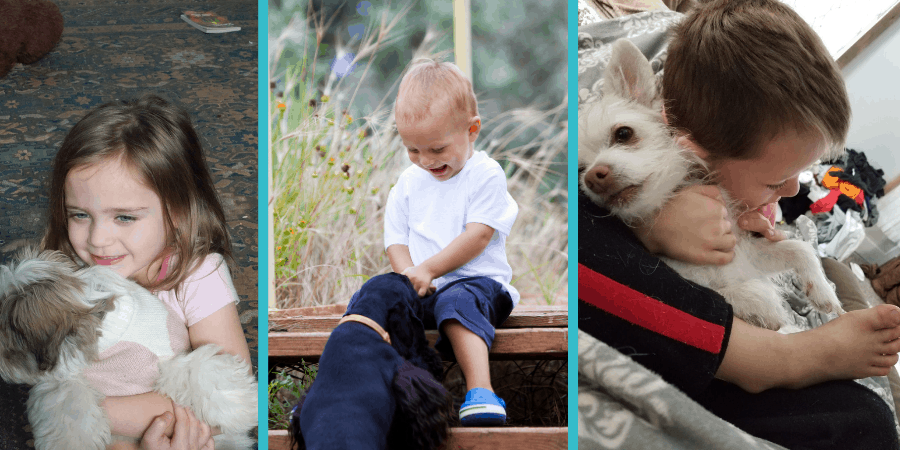
As a parent, it can be exhausting to hear yourself repeating 100 times a day “Leave The Dog Alone!” If you are tired of that not working and you are fearful of your dog reacting with aggression, it’s time to do something different.
Getting your toddler to leave the dog alone requires you to teach your child and the dog. There are Proactive steps you can take like setting ground rules, good training, creating space, good supervision, and there are reactive steps you can take like noticing warning signs, stepping in, and time apart.
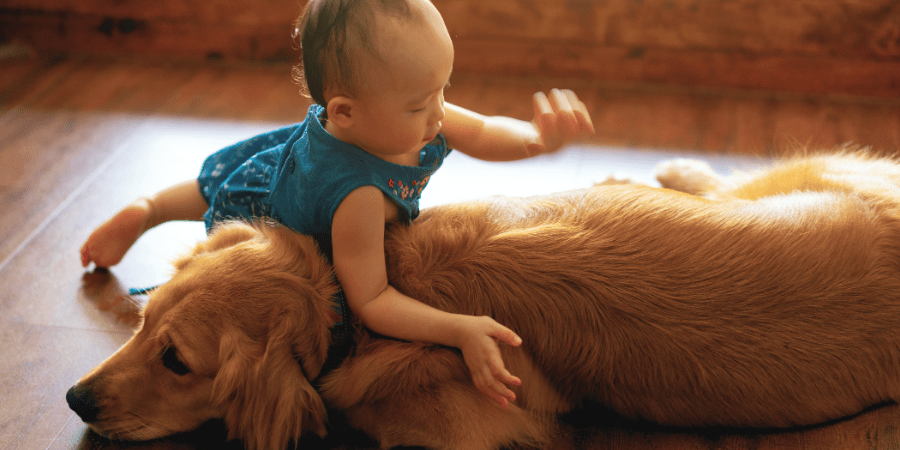
My hope in this article is to present you with the most useful and helpful tips to fill your parenting (dog & toddler) toolbox with so many options you’ll not only survive the fretful toddler years, but the relationship between your toddler and dog will be safe and thrive!
If you are brave enough to have gotten a new puppy while you are parenting a young child these tips will work for you as well!
Why Your Toddler is Obsessed With Your Dog?
Babies and toddlers are built to explore and learn about the world around them. Their brains are developing and growing more at this time in their life than they are at any time in the future. They want to touch, feel, mouth, hug, and eat everything.
Babies and toddlers are attracted to movement. When my daughter was a baby I could lie her on the floor under a ceiling fan and her eyes would follow it around and around for what seemed like hours. It’s the same reason that baby mobiles work so wonderfully.
Disclaimer: This post may contain affiliate links. We only recommend high-quality products that are used and recommended by real owners. If you use these links to buy something we earn a small commission.
Dogs are even better than the ceiling fan or a baby mobile. They move around even more and are on the floor almost in reach of that tiny little fist. They are soft and furry. They are very responsive, and they do funny things. To a toddler, they seem like the perfect friend, or more truthfully to them they seem like the perfect toy!
Often problems begin to surface at the time a child becomes mobile, either crawling or walking. They have more freedom and the ability to reach their furry friend. They want to explore everything there is to learn about the dog, and their little brains are completely unaware of the possible dangers that could arise by doing this.
In turn, your dog may also be curious about this newfound mobility of your toddler or baby. To your dog, your small child is more like a littermate or possibly another territorial animal. Your dog will not regard your child as a dominant figure in its life and will therefore not naturally submit to or treat your child with the same respect as it does you its owner.
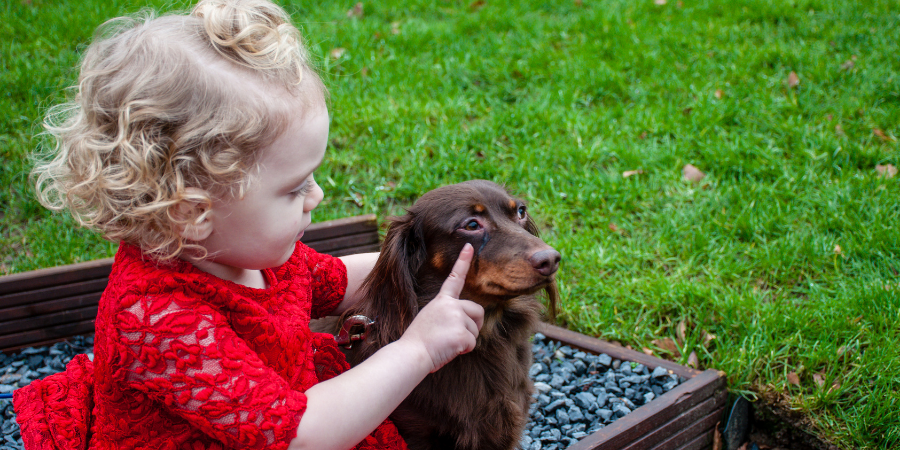
Why Your Dog May Be Scared or Anxious Around Your Toddler
Even if your dog is very well behaved, trained, and used to being around people, being around toddlers can be a stressful experience for them. Small children who are just beginning to be mobile and are very unsteady on their feet can make erratic and unpredictable movements. This can trigger anxiety in your dog, especially if your dog doesn’t have a lot of experience around young children.
Dogs rely on reading body language in order to understand us and to predict what we are expecting from them. Young children who lack social skills can send mixed signals to dogs making it difficult for our dogs to understand what is happening. Combine this with their high pitched voices and occasional ear piercing screams its no wonder that our furry friends work to avoid them.
On top of this toddlers also smell differently to your dog than adults do. Kids who have not gone through puberty have a different smell than we do as the adult in their life. They are also a lot smaller than adults and even sometimes smaller than some breeds of dogs. This puts them in a position below the dog which can be very confusing and lead your dog to mistrust or worse be aggressive toward your child.
Dangerous Combination: Dogs and Toddlers
Like I said before toddlers are working on making very important brain connections that will help them understand the world around them. They are learning boundaries and forming rules about cause and effect and what is and isn’t safe.
This is a long process that continues throughout their childhood. It’s important to remember that children younger than 3 are really not capable of understanding why something may be unsafe.
If your child was reaching out to touch a flame we would stop them and say NO don’t touch, that’s hot. They don’t know it will burn them or why you are saying no, but you keep them safe anyway. This needs to be the same way we think about keeping them safe around dogs.
Around age 3-5, they begin to understand more about the reasoning behind things. At this point, they start to make the connection that hot things hurt when touched and we don’t touch because we don’t want to get hurt.
This is still a hard concept to translate to a dog as dogs seem nice and friendly, and their personalities and tolerances vary so much. There doesn’t seem to be any obvious dangers. Dogs are also somewhat unpredictable, meaning depending on their current mood and activity they most likely won’t react the same way each time your child approaches them.
Another important thing to understand is that when very young children learn about things and start to associate words with objects they often doing something called overextending which means they may associate words like doggie to mean all animals instead of just doggie. This may also show up by them calling all dogs by the name of your dog, and thinking that all dogs will behave and act like your dog.
If your toddler is used to getting around your dog whenever they want, petting them, hugging them, and getting in their face, they will think this behavior is perfectly fine to do with all dogs. As you can guess this is very dangerous! You may have a good idea of how your dog will react, but other dogs can be very unpredictable!
Because of these associations the likely hood of your toddler approaching a strange dog so that they can hug, pet, or play with that dog the same as they do with your dog is very real and scary. It’s so important that they learn that they need to have permission first and that they need to approach with guidance and care.
Even if you have a very patient and socialized dog who does great around kids and doesn’t mind when your toddler grabs his ear and tries to put it in his mouth, allowing your toddler to explore and play with your dog can still be very dangerous! Even patient dogs have their breaking point and can lash out when feeling very threatened.
But I’m guessing if your toddler is currently obsessed with your dog, your dog may not be handling it well.
Practical Tips on How to keep your Child and Your Dog Safe
Monitoring all interactions between your toddler and dog really is the best way to do things, but let’s face it, it seems like an impossible task! Keeping track of your toddler’s every move on its own is exhausting, add in the pressures of caring for a needy dog or puppy and you’re done for.
As a mother of 4, I know the exhaustion that parenthood can entail especially by the time I had my 4th child. This is partly why (even though I LOVE and adore dogs) I waited until my youngest was 4 years old before we got a dog. I’m guessing that since you are here that’s not an option for you!
Here are tips other parents have successfully used. I have broken them down into manageable steps. Pick and choose what works or doesn’t work for you. It will take patience and some experimenting, but in time you can find a balance that works well for you and your family.
Here are the proactive ways to prevent dog bites and aggression.
Teach Your Child to Always Ask Permission
This is such an important step to teach your child! Not only will it be important for them with your own family pet, but even more importantly the skill will translate to them asking permission to touch or pet other dogs as well. This skill could save your child from a nasty bite from an aggressive dog!
Just as you teach your child to avoid other dangerous situations this is no different. They need to know that it’s important.
Be consistent – Don’t allow them to interact without permission and have them ask every time before they pet or touch your dog. This sounds difficult, but if you follow the tips below in keeping them separated as much as possible that will make this step easier.
Chose a simple phrase or word – As your child is very young and may not know how to communicate effectively it can be as simple as a hand signal meaning dog.
Baby sign language is a great way to start. The sign for a dog is to simply pat your leg. You can teach your child to get your attention and then pat their leg. That means they want to interact with the dog. You can then add words to that as their language skills develop.
Use a picture – Another way to teach them how to ask is to take a picture of your child with your dog, laminate it, stick a magnet to the back and hang it on the fridge. This can be a place that they go and point to when they would like to ask permission to interact with the dog.
Always Monitor……….Be Observant!
Any interaction between your dog and your child should be monitored! Being proactive in this step will be extremely helpful in preventing any aggression or poor behaviors developing between your child and dog.
Again not an easy task, but don’t worry we’ll talk about strategies for when you can’t monitor them below.
Here are some important questions to ask yourself before you allow interactions.
- How is your child feeling? What mood are they in, are they cranky, hungry, bored, tired. If yes, to any of these they may be more likely to irritate the dog.
- How is your dog feeling? Is it tired, hungry, irritated? If yes then it’s best to not allow interaction at this time.
- How are YOU feeling? Do you have the time to devote to being very active and present with your dog and child? Do you have the patience to work with them both to have a positive experience?
The best time for interaction is when your dog and child are both feeling their best and the experience is likely to be a positive one. It’s also important that you are able to be completely present, not distracted by doing other things. In order to have a positive experience, you will need to be aware of subtle cues from both your dog and your child to know when the situation is about to become more volatile and therefore is a good time to end the play session.
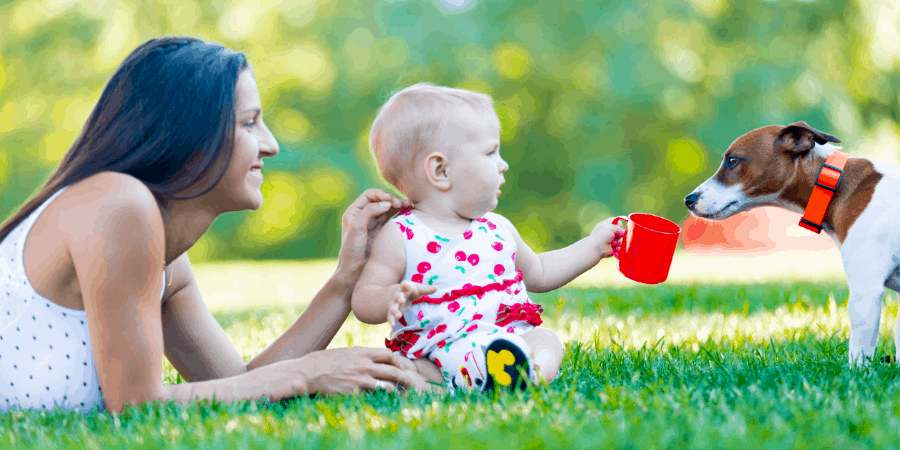
Learn To Read Dog Body Language!
Understanding your dogs cues and what they mean is a very important step in keeping interactions between your dog and your child safe.
You will need to get good at noticing the warning signs that your dog is feeling stressed and will need to end the interaction when that happens.
Changing gears and ending a play session with an enthusiastic toddler and their dog be difficult. It will be easier if you explain to your child beforehand that you are going to pay attention to how your dog is feeling so that you can help your dog stay happy. This is also a great skill to teach your child as they grow. This will help them to have a better relationship and stronger bond with each other going forward.
Here are some things to look out for.
- Licking the chops or nose
- Constant yawning
- Shivering or Shaking
- Panting
- Whale eyes or showing the whites of their eyes
- Tucked tail
- Lowered ears
- Cowering
- Pacing
- A rigid or stiff body! Watch out if you see this as it’s likely that your dog has had enough and their next move will be to snarl or bite!
- Snarling and biting. (You want to do your best to notice the signs of stress before your dog gets to this point!)
Here is a fun chart that can help you and your child better learn how your dog is communicating with you.
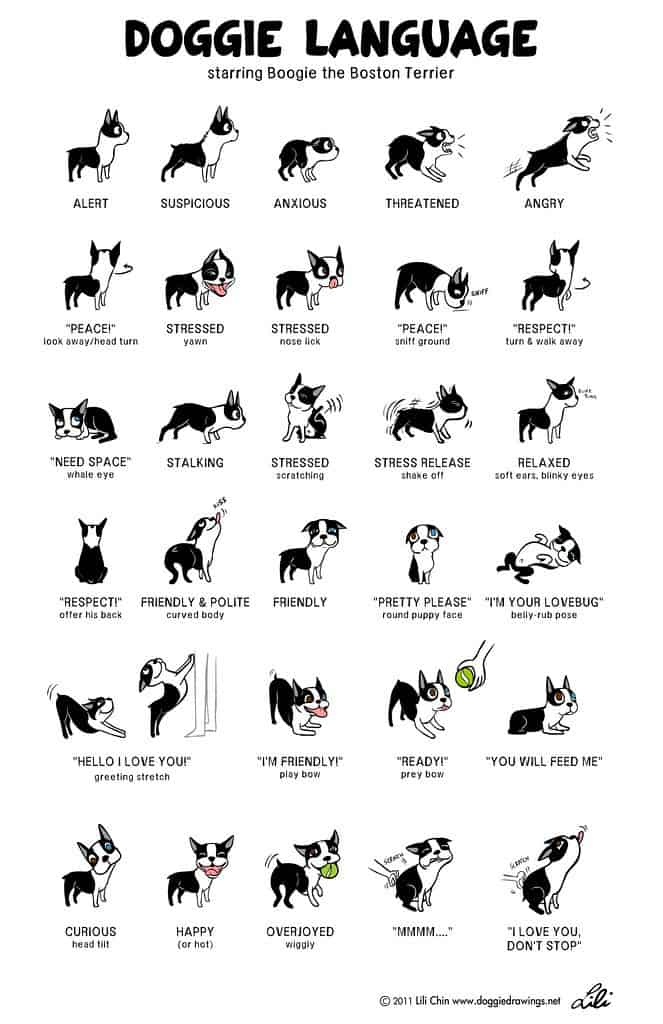
Source: https://www.flickr.com/photos/lilita/5652847156/sizes/l/
Add Play Sessions Into Your Schedule
It’s likely that as a parent of a toddler you already understand the importance of keeping a schedule. Having a schedule for your toddler is key to avoiding meltdowns, having easier naptimes, and making smoother transitions from one activity to the next. For more information about that check out this article about schedules by parents.com.
By following a schedule you can often better predict when your dog and toddler are going to be feeling their best and take advantage of those times for experiencing good interactions together. You can add your dog to your already scheduled playtime. With a schedule, you will have more control and consistency over when the interactions between your dog and toddler take place.
Here are some tips.
- Keep your play sessions short 5-10 minutes.
- Use the play sessions as an opportunity to teach.
- Help your child learn how to play appropriate games together with your dog, this will grow into more independent playtime together as they get older.
- Lighten your schedule! If you are feeling overwhelmed with taking care of your dog and toddler and the situation is getting dangerous it could be a good time to re-evaluate and figure out what you can prioritize differently. Nothing should be above the safety and learning of our child even if we have to plan on waiting until naptime to respond to an e-mail or check our Instagram feed.
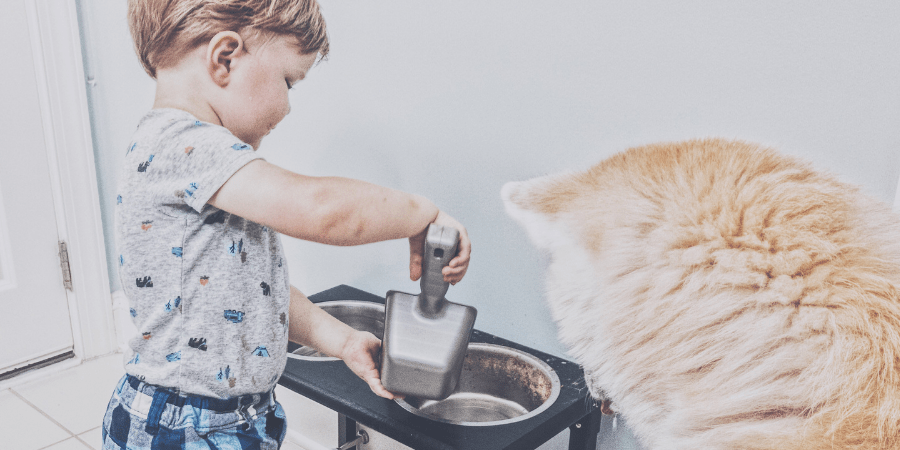
Help Them Feel Involved
If you have a toddler that is very enthusiastic, loves animals, and wants to be involved in everything your dog is doing this is the key to helping you make your life easier. Giving them specific things they can do to feel important in your dog’s life will help them focus that enthusiasm in the right direction.
This is also a very important tip for families who have a new puppy that your child won’t leave alone! This will get easier as they get older.
2-3 year old’s
Your Child’s most important job at this age is to learn how to touch their pet appropriately. This is the age that they want to pull, squeeze, or prod your dog just to see what they do.
Other age-appropriate helpful tasks could be to help pick out a few toys for their new dog to play with. They could learn to pick up the dog’s toys and hand them to you or put them in a specific place.
They could go with you to take the dog for a walk. You can ask them to show you or older siblings where do we keep our dog’s food or other items. Being able to answer that question will make them feel super helpful and important.
3-5 year old’s
At this age, they are still learning to touch and handle your dog properly. They are able to understand a little more about responsibility and caring for a living animal.
Some age-appropriate tasks for your child may be to feed your dog their food. This is more doable when you have already measured out the amount of food your dog needs then you can help your child pour the food in their dogs bowl. If you have an aggressive eater or very enthusiastic dog this may be a better chore for an older sibling.
Your child can help you take your dog for a walk by holding part of the leash, however they are still too young to have complete control over your dog.
If you have a fenced yard that your dog uses to go to the bathroom your child could help by opening and closing the door to let them in and out. Be sure that you teach your child to tell you that they are doing this so your dog doesn’t leave the dog out in the heat or cold without someone knowing.
5-7 year old’s
When we get to this age range we are out of the toddler years and things should start getting quite a bit easier with regards to your child and your dog. This age is when they can really start to learn more about what it takes to care for an animal and slowly gain more responsibility in helping.
Here is a helpful FREE printable that you can edit and print to give your child a chance to feel important in helping care for your dog. You can laminate or put it in a sheet protector like this. which will allow you to use a dry erase marker to check it off each day. Or you can just print multiple copies.
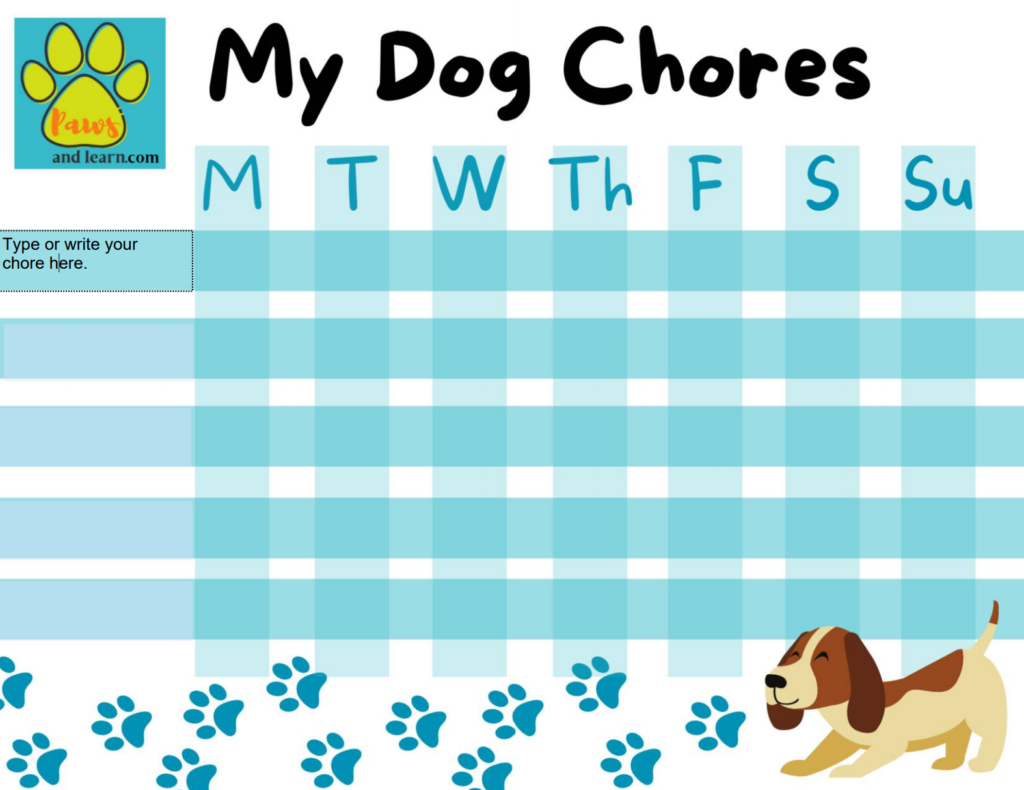
Create Safe Space
I don’t know about you, but when I am feeling overwhelmed and cranky I need a calm safe space that I can retreat to. The same is true for your dog and your toddler. Your dog’s safe space should be somewhere that is off-limits for your toddler. Crate training your dog works really well for that.
If you have an older dog here is a good article from Hillpet on how to crate train.
If you have a puppy here is a good article from the AKC on how to crate train a puppy.
This may be difficult at first, but if executed properly can be key to lowering your stress levels when dealing with your toddler and dog. One of the key ways to get that extra buffer of space between your dog and your toddler is to use a double-barrier system. This is where you have an extra buffer of space between your dog and child.
A way to do this would be to use double baby gates. This works good if you have a hallway you can use to implement this strategy.
I took some pictures of a set up that would work in my house. If you don’t have access to two baby gates, or don’t want to spend the money, you can get creative like I did. I used a metal drip pan that I bought years ago to make a magnet board for my kids.
Just make sure if you have a bigger dog, you test it out to see that it will hold up properly without injuring anyone.
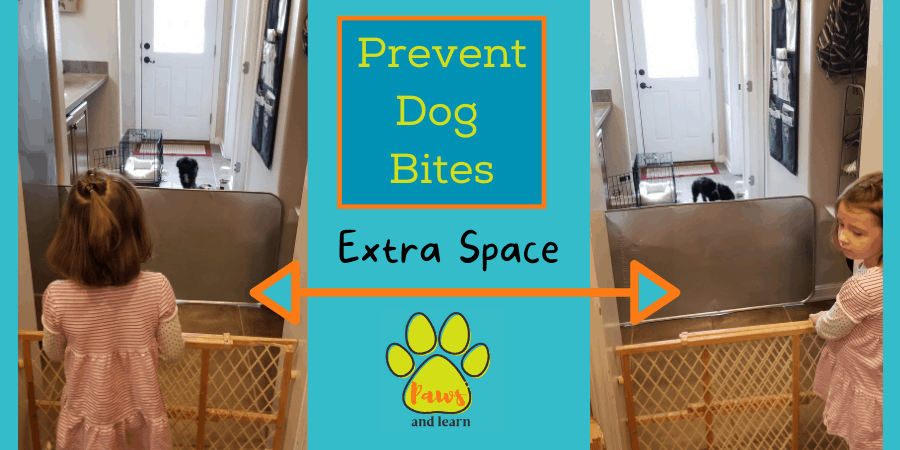
Another option would be a crated dog behind a closed door. If your toddler opens the door the dog is still not able to get to your toddler and you have some time to get to your child before they reach the dog. It’s also a great idea to have a calm down area or dog-free zone for your child to play in. If your toddler seems obsessed with your dog then you will need to employ the art of distraction. Finding other things to get keep your toddler’s attention focused on will help them forget about their desire to torture the dog. Also keeping your dog out of their site is important to help them forget about that desire as well.
If your child gets upset when you tell them no they can’t play with the dog, or you expect that it will be a hard transition to limit their time together you can create a calm down corner for them. This will help when they feel upset or frustrated when they can’t interact with the dog the way they are used to.
Not only does this help with emotions related to your dog, but can be super helpful in all aspects of life with your toddler.
Here is a great article from kiddie matter on how to create a calm down corner. You could add a stuffed dog for your child to hold and practice with.
And here is a video about how to set up a calm down corner.
Enlist Help Through Great Resources
If you have family members or friends that can pitch in for a while to help you with either your dog or your toddler this can be super helpful. As a busy mom myself I know getting a break for even just an hour or two can really impact my ability to press on and have continued patience.
There are a lot of online resources and places to look to get some extra help and support. So many people and other parents have gone through exactly what you are facing right now and have some great input and advice.
Here are the best and most helpful resources online!
Sign your Child up for a Class like this one that I teach for kids ages 3-6. This class is on a secure and safe website through Outschool.Com
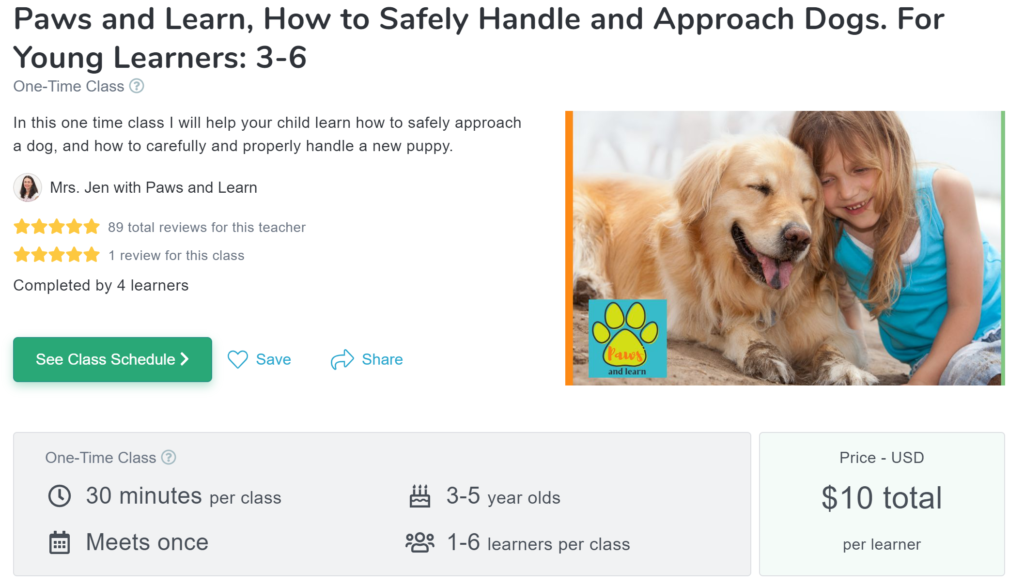
Books are a great way to teach your child about how to handle your dog.
Book Titles with Links to books on Amazon (affiliate links)
Good Dog in a Box
This website has a lot of great educational resources to help you teach your kids how to behave with and treat your dog. It is a resource that can grow with you and your family. They have videos on their website that you can watch with your children, as well as FREE printable resources such as coloring pages, and e-books.
I highly recommend you check out their bite prevention program and see if it’s something that can help you and your family!
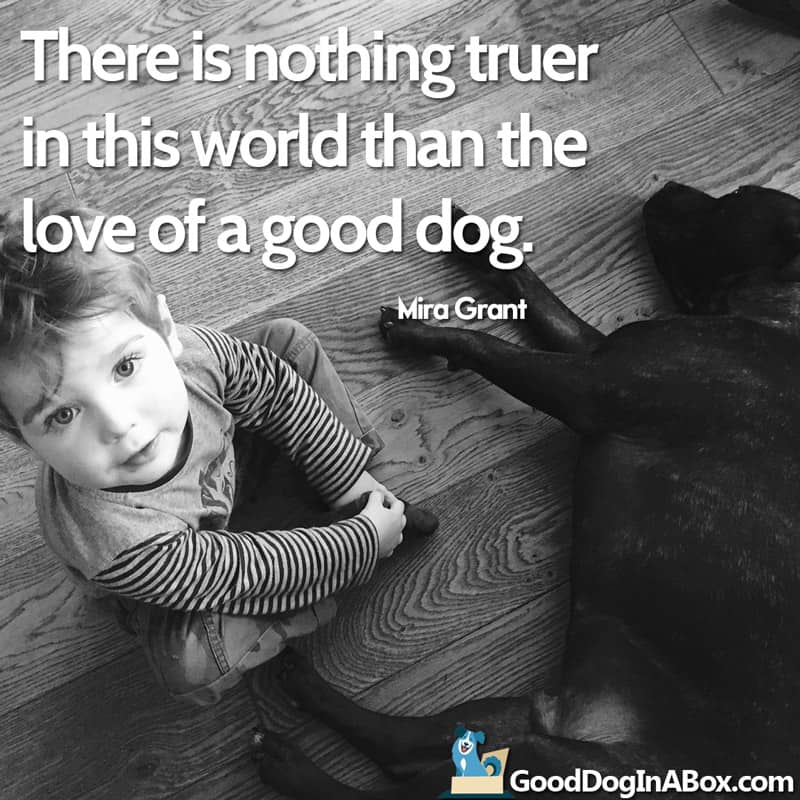
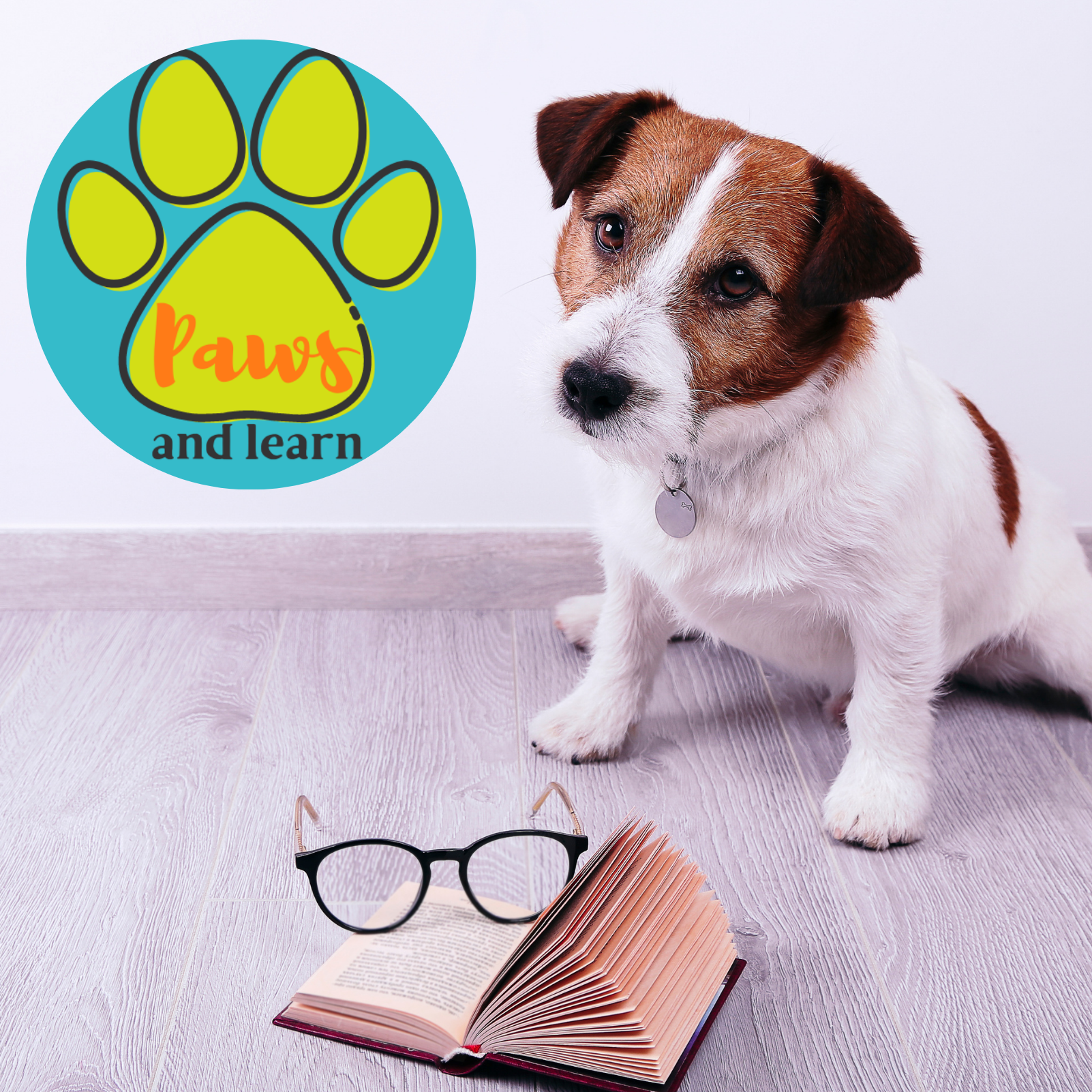

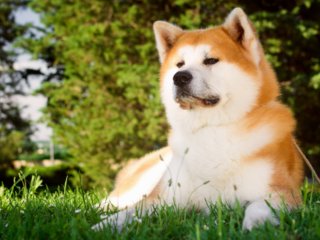
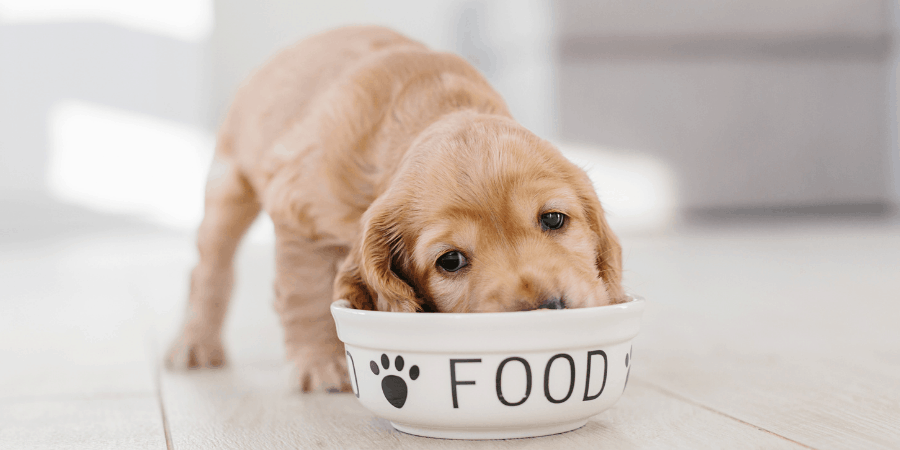
Why Do Puppies Hide Their Food, and Bury Their Treats? | Paws and Learn
Tuesday 2nd of March 2021
[…] She could still be hiding her things if she thinks that someone in your household may be a threat. Do you have a toddler who has recently become mobile? We all know how much little ones love trying out doggy toys and food! This could be a trigger for your puppy as well. Check out this article I wrote about getting your toddler to leave the dog alone). […]
Are Yorkies Jealous Dogs? (What to Do) | Paws and Learn
Saturday 27th of February 2021
[…] threatened since he’s so little and the new mobility of your child is endangering his space. Here is an article I wrote about toddlers and dogs that will be very helpful to you if you are in this […]
Why Do Chihuahua’s Hide their Food, and Burry their Treats? | Paws and Learn
Tuesday 23rd of February 2021
[…] ones love trying out doggy toys and food! This could be a trigger for your Chihuahua as well. Check out this article I wrote about getting your toddler to leave the dog alone) for tips and tricks on […]
Why Does Your Chihuahua Get Jealous, and What to Do? | Paws and Learn
Tuesday 23rd of February 2021
[…] threatened since he’s so little and the new mobility of your child is endangering his space. Here is an article I wrote about toddlers and dogs that will be very helpful to you if you are in this […]
Are Shih Tzus Good with Kids: A Guide for Parents | Paws and Learn
Sunday 21st of February 2021
[…] you have young kids this article I wrote about teaching your toddler to handle your dog with care is for […]